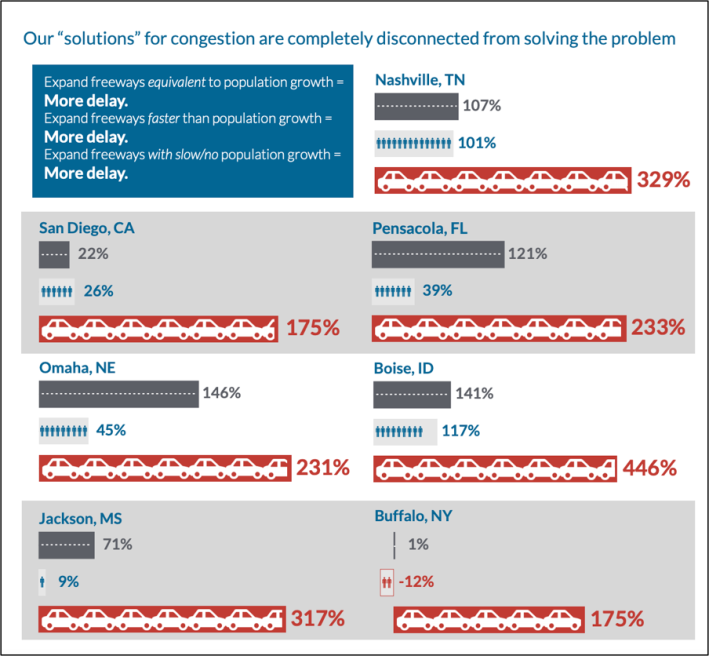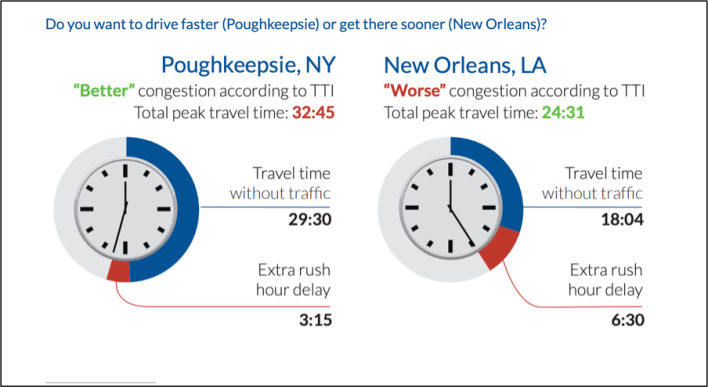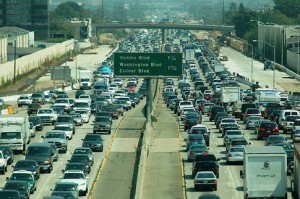The phenomenon of induced demand isn't news to Streetsblog readers. But a new report from Transportation for America illustrates exactly how stupid lane widenings really are.
The 100 largest urbanized areas in the U.S. added a whopping 30,511 miles of new freeway lanes between 1993 and 2017, according to the group. In case you're wondering, that means our road network is growing at a faster rate than our actual human population.
And here's the kicker: traffic actually got worse over those 24 years (which, how should we put this, kinda defeats the purpose of why taxpayers spent that money in the first place).

We shouldn't be surprised this happened. As experts have been saying since at least the 1960s, the more lane miles we build, the more drivers will come out of the woodwork to fill them — and the years between 1993 and 2017 were certainly no exception.

So, to recap: Americans spent a whole lot of money just to make car traffic worse, and the receipts are still coming in for the last three years that probably aren't much better.
But how much money are we talking about, exactly?
We're talking $500 billion. And that's just what the states paid — local transportation agencies kicked so much into these pointless projects that T4A wasn't able to accurately account for their losses.
Pause for a second to just think about how many buses, bike lanes and sidewalks $500 billion could have put in every single town in America. Heck, that could have paid for New York's Second Avenue Subway line 111 times over, and that's the most expensive train, like, ever.
[Excuse us as we black out from rage.]
OK, but wait, there's more!
We also have to pay to maintain all that stupid asphalt we bought now. Forever — or at until we get smart and rip it all out of the ground.
T4A zoomed out a bit and looked at how many roads the whole country built between 2009 and 2017, then multiplied it by the average annual maintenance costs for highway pavement.

But Streetsblog, you ask, maybe it was all worth it! Maybe my town was the magical exception to the induced-demand rule!
Spoiler: nope, it wasn't.

But Streetsblog, you say. I live in Poughkeepsie, and I never sit in traffic! Nobody lives here anymore, and we still have all these sprawling roads, so I can drive as fast as I want! It's awesome!
Uh, cool story, Mad Max, but...have you ever clocked how long it actually takes you to get where you're going in your town? Because these stats from the Texas Transportation Institute don't look so great to us:

And just in case you need a refresher, minimizing congestion does not equate to a great place to live.
I mean, I guess it's possible that poor guy walking with a grocery bag in the middle of five lanes of arterial traffic is living his best life, but...wouldn't he be a little happier if he was in a real "15-minute city" instead of staring down the grille of a pickup truck?

So, let's go over it all again:
- Building driving lanes and new roads for cars doesn't fix traffic jams.
- Building driving lanes and new roads for cars costs insane amounts of money.
- Building driving lanes and new roads makes cities more deadly for non-drivers.
- ...and even if you *do* see congestion drop, all those autocentric roads make your city sad and lame.
Know a doubter? Send them one of these graphics and let them know that #InducedDemandSucks.






